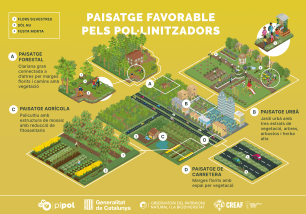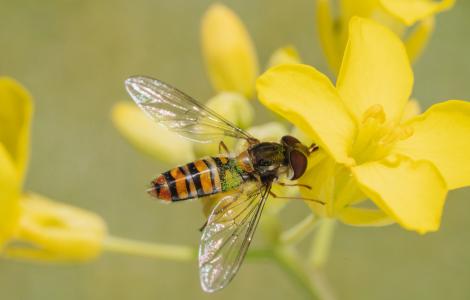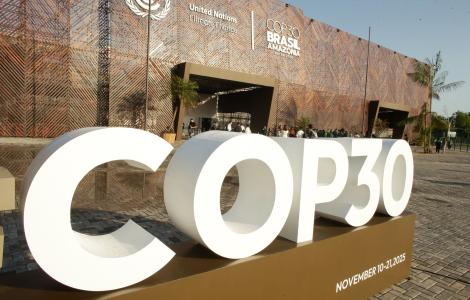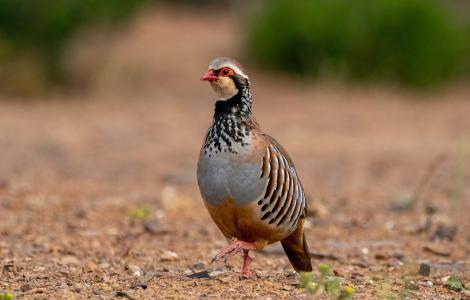The Department of Territory, Housing, and Ecological Transition of the sub-national Catalan government has promoted the Intersectoral Plan for Wild Pollinators of Catalonia (PIPOL). This document, which was preceded by a diagnosis of the conservation status of wild pollinators in Catalonia, outlines a series of priority objectives and more than thirty specific measures to reverse their decline, a problem of global scope, by 2030.
The Plan is the result of a broad participatory process and the work of an intersectoral commission made up of more than 60 people from universities and research centers, public administrations, the productive and agricultural sectors, businesses, and non-governmental organizations.
The Plan focuses on aspects such as the inclusion of wild pollinators in the planning and management objectives of protected natural areas, the identification and protection of areas of special interest for conservation, the promotion of good practices in agriculture, and the creation of favorable habitats for pollinators in urban and peri-urban settings. It also includes measures to improve knowledge and encourage public involvement in their conservation. The development of the PIPOL plan will be supported by CREAF and the Observatory of Natural Heritage and Biodiversity to ensure that it's implemented with proven scientific criteria and evidence.
During the presentation of the document, the Secretary of Ecological Transition, Jordi Sargatal, explained that "a program of specific actions will be promoted annually to achieve the objectives of the Plan. This year, being the first, has a special emphasis on the dissemination and awareness of the citizens to donate to raise awareness about what wild pollinators are and how important they are, because it is a major problem that the forest has disappeared and what we can do to reverse this situation”, Sargatal has highlighted. In this sense, a specific web portal on wild pollinitzadors in Catalonia has been launched, which will be the main point of reference for information and dissemination of PIPOL and all the initiatives and developments that it is producing in matters of conservation of these insects in Catalonia.
The secretary also explained that a governance committee will soon be established, comprised of the Generalitat of Catalonia and representatives from the sectors most relevant to the conservation of wild pollinators, to monitor the Plan’s implementation.
The Intersectoral Plan for the Conservation of Wild Pollinators in Catalonia is part of the Catalonia 2030 Natural Heritage and Biodiversity Strategy and is part of the European Union's Pollinator Initiative, which urges member states to promote instruments and actions to reverse the loss of wild pollinators. The Plan will also serve as a framework for developing the restoration measures for pollinator communities provided for in the European Commission's recent Nature Restoration Regulation, which came into force in 2024.
Mapping of Natural Pollinator Areas
Mapping of Natural Pollinator Areas
Among other measures, the Plan proposes to develop a map of Catalonia's natural and semi-natural areas of great importance for the conservation of wild pollinators. This map, which will also include connectivity zones between the different areas, will begin to be developed in 2025 and will allow for work on the creation of a network of nature reserves aimed at protecting entire pollinator communities.
At the same time, wild pollinators will be included in the planning and management objectives of protected natural areas, which will promote active management measures to maintain essential habitats for these insects, such as habitat restoration, compatibility of beekeeping activities with the conservation of wild pollinators, and the protection of vegetation areas that are particularly vulnerable to disturbance.

Forest landscape favorable for wild pollinators. Design: Nora Soler.
Likewise, the regulatory framework for subsidies for Catalonia's natural areas, habitats, and species is expected to incorporate a valuation criterion that promotes actions that have a positive impact on the conservation of wild pollinators, such as the creation or restoration of open spaces, the promotion of entomophilous margins, the creation of hedgerows with native species that provide food for pollinators, or the adaptation of nesting sites.
With this strategy, the Intersectoral Plan for the Conservation of Wild Pollinators in Catalonia seeks to make the management of this group a priority in the planning and management of protected natural areas.
Favorable habitats in urban environments
Favorable habitats in urban environments
The PIPOL pays special attention to the need to promote favorable habitats for pollinators in urban and peri-urban environments. It should be noted that the development of urbanization and infrastructure has been one of the most important factors in land transformation over the last century. Currently, 4.42% of Catalonia's land area is classified as urban land and 2.17% as developable land. Road and communication infrastructure occupy a relatively small area (only 0.21% of the territory) but generate significant fragmentation. All of this affects wild pollinators, particularly because it leads to the elimination of native vegetation, their food source, and the alteration of the nesting substrates on which they depend.
However, the urban environment can provide some opportunities for pollinator conservation and public awareness. Urban and peri-urban green spaces have great potential as favorable habitats if ecological connectivity is maintained.
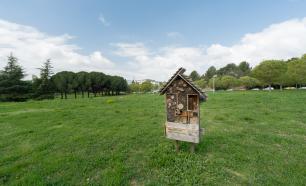
Bee hotel located on the campus of the Autonomous University of Barcelona. Image: Galdric Mossoll.
The Plan proposes measures such as the publication of technical guides to promote wild pollinators in urban and peri-urban environments. A clear example would be the recently published Guide to Greening the Resilient Mediterranean Garden, prepared by the Department of Territory, Housing, and Ecological Transition with the support of the Gardening Guild of Catalonia. Actions are also contemplated to incorporate technical criteria for the promotion and conservation of pollinators in the planning of urban and peri-urban municipal green infrastructure, as well as in urban planning; the programming of training on wild pollinator conservation for municipal officials and training schools in architecture, landscaping, and gardening; and the creation of pollinator microreserves, building on the momentum of similar initiatives such as butterfly and pollinator gardens, of which there are already more than one hundred throughout the country.
Promoting pollinator populations in environments associated with infrastructure
Promoting pollinator populations in environments associated with infrastructure
Infrastructures, such as roads and railways, have easements and side verges that, despite their exposure to traffic and pollution, can be attractive habitats for many pollinators. Furthermore, these spaces adjacent to road infrastructure can also serve as connectivity corridors for pollinators between different natural areas.
Furthermore, infrastructures such as wastewater treatment plants, other water cycle facilities, municipal landfills, and some industrial estates have large unpaved surfaces that are not work or transit areas and have controlled public access. These spaces can serve as connectors and transition areas between urban areas and the natural environment.
For all these reasons, the Plan aims to promote, among other measures, the creation of a network of pollinator corridors supported by major road, rail, and electricity infrastructure. Managing these generally wide easements to promote insect habitats should not pose any risk to the operation of the infrastructure. On the contrary, it would make vast areas of useful habitat available to pollinators.
Promoting good practices and favorable habitats in the agricultural environment
Promoting good practices and favorable habitats in the agricultural environment
The agricultural sector, which depends on natural pollinator communities for production, is a key element in halting the loss of this biodiversity. In this regard, the Plan has included the participation of the Department of Agriculture, Livestock, Fisheries, and Food and includes a series of specific measures to collaborate with the sector in the conservation of pollinating insects, such as the introduction of a specific module on wild pollinators in agricultural training and advisory programs, or the development of educational materials and technical guides aimed at the sector so they can benefit from the free pollination offered by these insects.
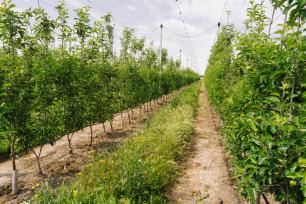
Organic apple orchard with flower bands between the rows of fruit trees. Image: Galdric Mossoll.
Likewise, it emphasizes the need to encourage more sustainable agricultural practices, such as the conservation, installation, and maintenance of crop field margins, and especially supports sustainable agricultural production, organic farming, and integrated production, models that are more respectful of pollinators and biodiversity.
The Plan also refers to the promotion of integrated pest management and alternative control methods to chemical products, in order to reduce the use of pesticides as much as possible.
Pollination, a crucial ecosystem service
Pollination, a crucial ecosystem service
Pollination is an irreplaceable ecosystem service, as nearly 90% of wild flowering plants depend on pollinators to produce fruits and seeds. Furthermore, it contributes decisively to agricultural production and is essential for ensuring food security. Of the world's main crops, 75% depend to a greater or lesser extent on pollination, primarily by wild insects, to produce fruits and seeds. It is estimated that currently 51% of agricultural land in Europe suffers from pollination deficit. A total absence of pollinators would result in a 7% decrease in production, with losses of €3 billion annually. In Catalonia, the value of insect pollination of crops is estimated at between €290 and €321 million annually. It is estimated that there are approximately 700 species of bees alone, and more than 200 species of diurnal butterflies.
For all these reasons, the Plan aims to promote, among other measures, the creation of a network of pollinator corridors supported by major road, rail, and electricity infrastructure. Managing these generally wide easements to promote insect habitats should not pose any risk to the operation of the infrastructure. On the contrary, it would make vast areas of useful habitat available to pollinators.



